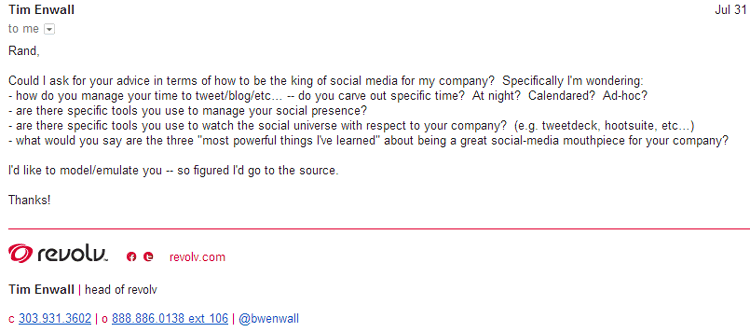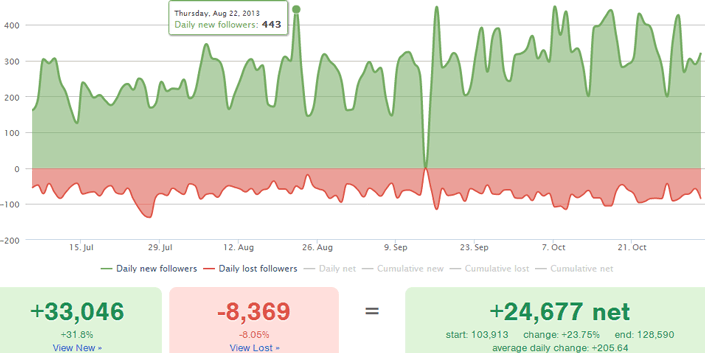One of the best parts about Foundry’s investment in Moz last Spring was the incredible access to other CEOs, founders, and companies in their portfolio. I’ve had at least a half dozen phone conversations, more than a dozen in-person chats, and a few invaluable get-togethers with my Foundry cousins and learned a tremendous amount every time. It’s something I hope every VC & investor is doing, because these connections are emotionally and professionally fulfilling in ways I never could have imagined before I got to join in.
So, naturally, when Tim Enwall, founder of Revolv (which makes an awesome gadget that connects your phone to all sorts of devices in your home), reached out with the email below, I felt obligated to give back:

I asked Tim if I could turn his email into a blog post, and he agreed (thanks Tim!). I’ll start by saying that my tools & processes are different today than they were when I began my marketing career, but I’ll try to provide advice that’s useful and actionable by those just starting out, too.
Carving Out Time
Time as a CEO is precious and rare, but it’s not quite as bad as we sometimes make it out to be. The nice thing about social is that, for me at least, it lets me feel and be connected to the broader communities I engage in without a large time commitment. Staying up to date on the four primary networks I use (Twitter, Google+, LinkedIn, and Facebook) isn’t usually more than 45 minutes a day, broken up into chunks of between 30 seconds and 10 minutes.
Granted, that’s using social media in what I’d call “maintenance mode” rather than “active investment” mode. When I was starting out, I did more content creation, more web-wide participation, and more sharing of all kinds.
Nowadays, I have three primary activities: I share things I find interesting, help amplify what others have shared, and reply to those who engage with me. For me, those interactions are both enjoyable and thought-provoking. They help me think bigger than my day-to-day at Moz, and hold me accountable to a wider swath of my fellow startuppers, executives, marketers, techies, and social media users.
Let’s get specific. Below, I’ve created a look at my day:

Social media fits in “wherever.” It’s heaviest in the morning and the evening when I’ll spend uninterrupted blocks of 10-15 minutes skimming, participating, replying, and sharing. It’s far more intermittent in the middle of the day, when I check in between meetings or while traveling (though I try to be careful not to do it while walking outside!).
My style of usage isn’t formally calendar’d, but it isn’t wholly ad-hoc either. Those blocks help insure I’m almost never unreachable for multiple days in a row. I also keep the number of people I follow very carefully curated, seeking out only those whose content is interesting and useful from a business case standpoint in 30%+ of their shares (and higher if they share more).
All in all, this isn’t an intensive process for me. It feels natural and comfortable, and I always learn something by skimming my feeds. That alone makes my investments in social ROI-positive.
Starting the Social Media Process
To me, social media is an intentional, strategic process. If you’re seeking to lead social efforts for your company, I’d encourage you to take this approach, too. Here’s how I think about it – to do my job effectively as CEO, I need to both evangelize (push) and listen (interact/engage) to many unique audiences like these:
- Seattle area folks – We’re constantly recruiting for a large number of competitive roles, so we need people knowing who we are, what we stand for, why we’re a good company to work for, and whom we’re seeking.
- Startup industry – Over the course of my tenure as CEO, we’ve leaned heavily on our network of fellow startup executives, investors, media folks, and other participants. Activities like fundraising and board composition in particular are helped by this group.
- Marketers – These people aren’t just our potential future customers, they’re the group we’re sworn to assist. Moz’s mission is to help marketers succeed, and to help, we need to be in touch.
- Moz Customers – Our most important audience and one that often like to engage with us through social. If we’re not there for them, we can expect some disappointment.
- Moz Employees – I love to be available for both fun and work-related conversations on social. We could do email, but it’s not quite as uniquely transparent or as serendipitous.
- Potential amplifiers – Anyone who has the power to spread our message and a potentially interested audience (like those above) fits this category. When thinking about social, I often start with the core groups above, and then try to add in those who might influence them and how I can reach them, too.
Social media is the most practical, scalable, and affordable way that I can interact these communities, and thankfully, they’re all heavy users of the social networks I know and love.
My primary point of leverage is empathy. I’ve lived in Seattle since I was 3 months old. I’ve struggled mightily in the startup industry for nearly a decade. I’ve been a marketer for my entire adult life. I was the first Moz customer (before we opened our tools to the public, we’d built them so I could use them to help consulting clients with their SEO). I’m tied for being the first Moz employee (with my Mom). And, finally, thanks to the size of my networks, I’m an amplifier myself.
These overlaps mean that I can put myself in the shoes of these folks and envision what they’d want to find on a social account they follow. I can feel their frustration when their comment doesn’t elicit a response. I can take joy in the value the right answer to a tough question provides. I can sense their elation when something they’ve shared is re-shared by others. I’ve been in all these situations personally, and I try to re-live them mentally as I ask myself questions like “should I share this?” and “what have I done for my Facebook audience lately?” and “where can I add value in the 5 minutes I’ve got in the back of this cab?”
If I were starting from scratch today, I’d follow this same path – join the groups I want to influence. Experience their pain. Then participate and share to help. It’s exactly what entrepreneurs do when building a product, and we should apply that same logic to the social media process.
One of my favorite bloggers put it well:
At some point, you’ll spend hours looking for something online. A guide, a piece of information, some help about some topic that’s pressing on you. And if you don’t find it, you need to sit down and write the post yourself.
That’s as true in social sharing as it is in the world of blogging or content creation.
Tools for Management & Observation
Here’s my dirty secret – I don’t use any social management tools.
Not Buffer or HootSuite or Tweetdeck or ManageFlitter or SproutSocial or anything else. I do use Moz Analytics to track how I’m doing in growing my networks and earning traffic (e.g. the chart below from FollowerWonk is one of my favorites) and bit.ly to track some comparable vanity metrics, but if I were scrimping on dollars, I could just record my stats weekly in a Google Spreadsheet.

I do have all of my social networks on my phone, so I can easily share and engage when not in front of my computer, but that’s about it. I know our community management team at Moz uses far more tools, but they have multiple accounts, far more responses to track, and significantly more networks too.
The 5 Most Powerful Things I’ve Learned About Being a Social Media Representative for My Startup
Since Tim asked, here’s the best short-form advice I’ve got:
- Social success for your startup is not the same as social success on your personal accounts. But, I still like to make 1/10 social shares personal rather than professional.
- Keep a high signal to noise ratio, but don’t be afraid of sharing something more than once. Remember that if you have a geographically distributed audience, you likely have folks who are on social at very different times.
- Social is a conversion funnel process just like any other form of marketing. Make sure you’re exposing and delivering consistent value from first exposure (your profile) to conversion (earning that fan/follower), to retention (keeping your audience engaged).
- Don’t just broadcast; interact. That means replying, reaching out, and, my favorite, helping others to spread their great ideas and content.
- Test, track, analyze, and optimize. Social is a lot like SEO, but instead of algorithms, there are far more complex human beings mapping your success. Thankfully, unlike SEO, social isn’t a zero sum game.
Why Should CEOs Be Social Leaders?
Actually, I don’t think every CEO should be a social leader for their company. If you don’t have the passion, aptitude, curiousity, or willingness to experiment, you’re probably better off using your time and energy elsewhere. The CEO isn’t the only one who can help their company achieve traction in social channels.
That said, the CEO is a particularly powerful one for social participation. There’s an authenticity and transparency inherent in a CEO contributing directly and publicly over a channel that can instantly be amplified to reach millions. If you have the maturity/judgement to participate in consistently positive ways that represent your company’s values and brand honestly, it can be a needle-moving activity in recruiting, fundraising, networking, customer acquisition, press, and many other key objectives for your business.
—————-
Many thanks to Tim for the great question, and my sincere apologies it’s taken me this long to finally publish a cogent response. I’m sure there’ll be lots more excellent advice in the comments, too.
